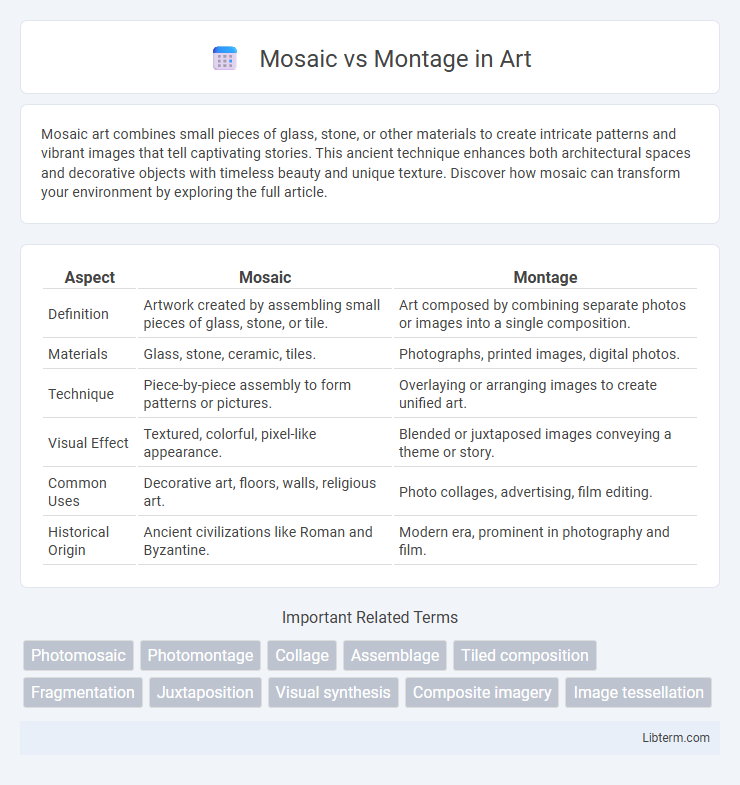Mosaic art combines small pieces of glass, stone, or other materials to create intricate patterns and vibrant images that tell captivating stories. This ancient technique enhances both architectural spaces and decorative objects with timeless beauty and unique texture. Discover how mosaic can transform your environment by exploring the full article.
Table of Comparison
| Aspect | Mosaic | Montage |
|---|---|---|
| Definition | Artwork created by assembling small pieces of glass, stone, or tile. | Art composed by combining separate photos or images into a single composition. |
| Materials | Glass, stone, ceramic, tiles. | Photographs, printed images, digital photos. |
| Technique | Piece-by-piece assembly to form patterns or pictures. | Overlaying or arranging images to create unified art. |
| Visual Effect | Textured, colorful, pixel-like appearance. | Blended or juxtaposed images conveying a theme or story. |
| Common Uses | Decorative art, floors, walls, religious art. | Photo collages, advertising, film editing. |
| Historical Origin | Ancient civilizations like Roman and Byzantine. | Modern era, prominent in photography and film. |
Understanding Mosaic and Montage: Key Definitions
Mosaic is an art form that creates images or patterns by assembling small pieces of colored glass, stone, or other materials, emphasizing texture and individual tile arrangement. Montage refers to a film or photo editing technique that combines multiple images or clips to convey a condensed narrative or thematic message through sequential juxtaposition. Understanding these key definitions highlights mosaic's physical, tactile construction compared to montage's temporal, visual storytelling.
Historical Origins of Mosaic and Montage
Mosaic art dates back to ancient Mesopotamia and Greece, where small pieces of colored glass, stone, or ceramic called tesserae were used to create intricate floor and wall designs. Montage emerged in the early 20th century within the Soviet film industry, pioneered by filmmakers like Sergei Eisenstein, who used rapid editing and juxtaposition of images to convey complex ideas and emotional responses. While mosaic emphasizes assembling physical pieces into a static image, montage focuses on combining film footage to create dynamic narrative meaning.
Artistic Principles: How Mosaic Differs from Montage
Mosaic art involves assembling small, colored pieces of glass, stone, or tile into a unified image, emphasizing texture, pattern, and materiality, which creates a tactile and dimensional quality. Montage, by contrast, integrates multiple photographic images or fragments into a single composition, prioritizing visual juxtaposition and conceptual narrative over material texture. The artistic principle in mosaics lies in precision craftsmanship and color harmony, while montage centers on thematic layering and visual storytelling through image combination.
Materials and Mediums Used in Mosaic vs. Montage
Mosaics are created by assembling small pieces of materials such as glass, stone, ceramic, or tile to form intricate patterns and images, often set into a cement or mortar base. Montages typically involve the combination of photographs, film clips, or digital images, digitally or manually layered or juxtaposed to generate a composite visual narrative. While mosaics emphasize physical texture and permanence through durable, tangible mediums, montages prioritize flexibility and temporal storytelling by utilizing ephemeral or digital materials.
Techniques and Processes in Mosaic Creation
Mosaic creation involves assembling small, colored pieces called tesserae made from materials like glass, stone, or ceramic, carefully arranged to form detailed patterns or images. The techniques include direct method, where tesserae are placed directly onto the adhesive surface, and indirect method, which uses a temporary backing to arrange pieces before final installation, enhancing precision and flexibility. Grouting fills spaces between tesserae, securing the design and adding durability while allowing for creative color contrasts and texture effects.
Methods and Styles in Montage Art
Mosaic art involves assembling small pieces of colored glass, stone, or other materials to create detailed, durable images, often characterized by geometric patterns or tessellations. Montage art, particularly in film and photography, employs a method of combining multiple images or scenes to convey complex narratives or emotions through rapid sequence, juxtapositions, and layering techniques. Styles in montage art range from Soviet montage's rhythmic editing to more contemporary digital collage approaches, emphasizing dynamic visual storytelling distinct from the static, structured composition of mosaics.
Visual Impact: Comparing the Aesthetics
Mosaic art creates a textured, pixelated visual impact by assembling small, colored pieces to form intricate patterns and images, emphasizing detail and durability. Montage, in contrast, combines multiple photographic or video elements to produce dynamic, layered visuals that convey movement and narrative complexity. The aesthetic of mosaics highlights craftsmanship and permanence, while montages prioritize fluid storytelling and emotional resonance through juxtaposition.
Applications in Modern Art and Media
Mosaics and montages serve distinct roles in modern art and media, with mosaics primarily applied in large-scale installations and public art to create visually impactful, tessellated imagery using small, durable pieces such as glass or stone. Montages dominate digital media, film, and graphic design by combining multiple images or video clips to convey complex narratives or thematic ideas effectively. Both techniques enrich visual storytelling, but mosaics emphasize texture and pattern through physical materials, while montages exploit digital layering and editing for dynamic, temporal compositions.
Cultural Significance and Influences
Mosaic art, originating from ancient Mesopotamia and flourishing in Byzantine culture, serves as a symbolic medium embedding religious and cultural narratives through small, colored pieces of glass or stone. Montage, developed in the early 20th century within Soviet cinema and later embraced globally, strategically juxtaposes imagery to create new meanings and evoke emotional responses, influencing visual storytelling across media. Both techniques profoundly shaped cultural expressions by reflecting societal values and enabling complex communication through visual composition.
Choosing Between Mosaic and Montage for Your Project
Choosing between mosaic and montage for your project depends on the visual effect and texture you want to achieve. Mosaics use small pieces of glass, stone, or tile to create a detailed, intricate pattern ideal for decorative and architectural applications. Montages combine multiple images or clips to tell a story or convey a theme, making them perfect for multimedia presentations and artistic compositions.
Mosaic Infographic

 libterm.com
libterm.com